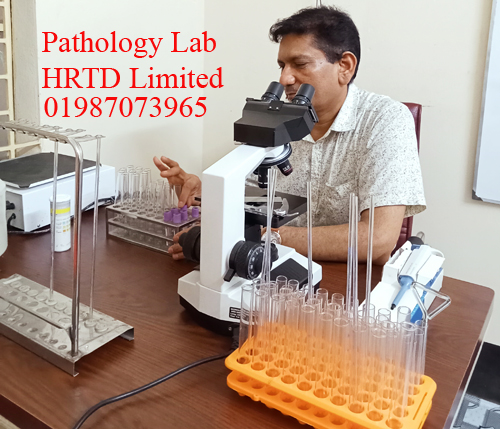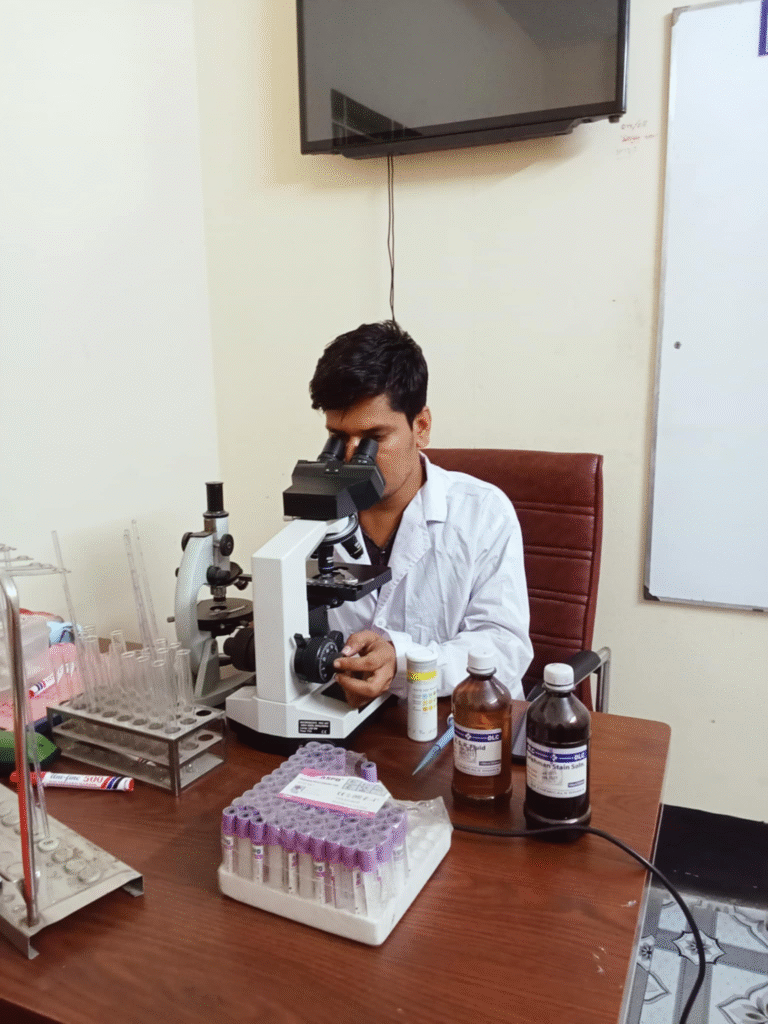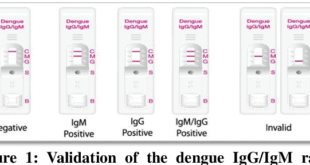Gamma Glutamyl Transferase Test

1. Introduction
Gamma Glutamyl Transferase (GGT), also known as Gamma Glutamyl Transpeptidase, is an essential enzyme found predominantly in the liver and biliary tract. It plays a critical role in the transfer of gamma-glutamyl functional groups from peptides to other molecules, aiding in amino acid transport and glutathione metabolism.
From a clinical perspective, estimation of serum GGT activity is a crucial diagnostic tool in hepatobiliary diseases, alcohol abuse, and various forms of liver dysfunction. At HRTD Medical Institute, the GGT test is taught as part of advanced biochemical and pathological analysis, emphasizing its role in clinical chemistry, enzymology, and diagnostic interpretation.
2. Biochemical Background of GGT
2.1 Nature and Structure
Gamma Glutamyl Transferase is a membrane-bound glycoprotein enzyme located on the external surface of cell membranes. It catalyzes the transfer of the gamma-glutamyl group from glutathione to acceptor molecules, forming gamma-glutamyl peptides.
The enzyme exists in high concentrations in the following organs:
- Liver (especially bile canaliculi and hepatocytes)
- Kidney (proximal tubular cells)
- Pancreas
- Intestines
- Spleen and brain (in minor amounts)
GGT functions as a dimer with molecular weight ranging between 68–90 kDa. The active site contains cysteine residues that participate in enzymatic catalysis.
2.2 Enzymatic Reaction
The principal reaction catalyzed by GGT is:
γ-Glutamyl Peptide + Amino Acid → Peptide + γ-Glutamyl Amino Acid
This reaction facilitates:
- Glutathione breakdown
- Amino acid absorption
- Detoxification processes
2.3 Physiological Role
- Glutathione metabolism: Helps maintain cellular antioxidant balance.
- Amino acid transport: Transfers amino acids across cellular membranes.
- Liver detoxification: Participates in conjugation and excretion of xenobiotics.
Students at HRTD Medical Institute learn to relate these biochemical functions with clinical implications, especially in hepatic physiology and pathology.

3. Clinical Significance of GGT
GGT levels in serum provide vital information about hepatobiliary function. Elevated GGT often indicates cholestasis or hepatocellular injury.
3.1 Common Clinical Conditions Associated with Increased GGT
| Category | Conditions | Remarks |
|---|---|---|
| Hepatobiliary Diseases | Hepatitis, Cirrhosis, Cholestasis, Obstructive Jaundice | GGT increases early in bile duct obstruction |
| Alcohol Consumption | Chronic alcoholism | Marker for ethanol-induced liver damage |
| Drug-Induced Enzyme Induction | Phenytoin, Barbiturates, Rifampicin | GGT increases due to microsomal enzyme induction |
| Pancreatic Disorders | Pancreatitis, Pancreatic carcinoma | GGT elevated due to biliary obstruction |
| Cardiac Diseases | Congestive heart failure | Mild elevation due to hepatic congestion |
| Renal Diseases | Renal tubular dysfunction | GGT activity seen in urine more than serum |
3.2 Decreased GGT Activity
Although less clinically significant, decreased GGT levels may occur in hypothyroidism or genetic GGT deficiency.
4. Indications for the Test
The Gamma GT Test is recommended for:
- Assessing liver function when other liver enzymes (ALT, AST, ALP) are abnormal.
- Differentiating between hepatic and bone origin of alkaline phosphatase (ALP).
- Monitoring alcohol abstinence or relapse in chronic alcoholics.
- Evaluating the effects of hepatotoxic drugs.
- Investigating cholestatic jaundice and biliary obstruction.
- Screening patients with suspected liver disease.
At HRTD Medical Institute, trainees are taught to correlate GGT levels with a patient’s history, physical examination, and other biochemical test results to arrive at an accurate diagnosis.
5. Specimen Collection and Handling
5.1 Specimen Type
- Serum is the preferred sample for GGT estimation.
- Heparinized plasma may also be used, though serum remains standard.
5.2 Collection Procedure
- Collect 2–3 mL of venous blood in a plain tube.
- Allow clot formation at room temperature for 15–20 minutes.
- Centrifuge to separate serum.
- Perform the test immediately or store the serum at 2–8°C for up to 24 hours.
5.3 Precautions
- Avoid hemolysis; red cells contain GGT, which may alter results.
- Fasting samples preferred, as food intake can influence enzyme levels.
- Avoid alcohol for at least 24 hours prior to collection.
At HRTD Medical Institute’s diagnostic laboratory, students learn these steps under expert supervision, emphasizing accuracy and quality control.
6. Principle of the Test
6.1 Enzymatic Principle
The GGT activity is measured using a kinetic colorimetric method. The enzyme catalyzes the transfer of a gamma-glutamyl group from a donor substrate (usually L-γ-glutamyl-p-nitroanilide) to an acceptor (glycylglycine), releasing p-nitroaniline, which can be measured spectrophotometrically at 405 nm.
Reaction:
L-γ-Glutamyl-p-nitroanilide + Glycylglycine → L-γ-Glutamyl-glycylglycine + p-Nitroaniline
The rate of increase in absorbance is directly proportional to GGT activity.
6.2 Reference Method
The International Federation of Clinical Chemistry (IFCC) recommends the standardized kinetic method for GGT estimation at 37°C.

7. Reagents and Equipment
7.1 Reagents
- Substrate: L-γ-Glutamyl-p-nitroanilide
- Buffer: Tris-HCl (pH 8.2–8.5)
- Accepting molecule: Glycylglycine
- Working reagent: Ready-to-use mixture of buffer and substrate
7.2 Equipment
- Semi-automated or automated chemistry analyzer
- Micropipettes and tips
- Cuvettes
- Centrifuge
- Water bath (for temperature control)
In HRTD Medical Institute’s Biochemistry Laboratory, students perform this assay both manually and using automated analyzers to gain hands-on experience in enzymatic analysis.
8. Procedure
Manual Kinetic Method
- Label test tubes as Blank, Standard, and Test.
- Add reagent as per manufacturer’s instruction (usually 1 mL).
- Add 100 µL of serum sample to the test tube.
- Mix gently and incubate at 37°C.
- Measure absorbance change at 405 nm for 1–3 minutes.
- Calculate GGT activity using standard formula:
GGT Activity (U/L) = (ΔA/min × Total Volume × 1000) / (ε × Path length × Sample Volume)
Where ε (molar absorptivity of p-nitroaniline) = 9.9 × 10³ L/mol/cm.
9. Reference Values
| Population | Reference Range (U/L) |
|---|---|
| Adult Male | 10 – 50 |
| Adult Female | 7 – 32 |
| Children | Up to 20 |
| Newborns | Up to 180 (decreases with age) |
Reference intervals may vary with reagents and instruments. Each laboratory at HRTD Medical Institute establishes its own range based on standard calibration.
10. Interpretation of Results
10.1 Elevated GGT
- Liver Cell Injury: Acute or chronic hepatitis, cirrhosis.
- Cholestasis: Early rise in GGT, often higher than ALT or AST.
- Alcohol Abuse: Persistent elevation due to microsomal induction.
- Drug-Induced Liver Damage: Anticonvulsants and barbiturates.
- Pancreatic or Cardiac Disorders: Secondary increase due to hepatic congestion.
10.2 Normal or Slightly Raised GGT
- Fatty liver or mild hepatic steatosis.
- Subclinical or resolving hepatic disease.
10.3 Correlation with Other Tests
- GGT + ALP: If both are raised → hepatic origin.
- ALP high but GGT normal → bone disease.
- GGT + ALT + AST: Indicates hepatocellular injury.
Students at HRTD Medical Institute learn to interpret these enzyme patterns as part of liver function test (LFT) profiles.
11. Factors Affecting GGT Levels
| Factor | Effect | Notes |
|---|---|---|
| Alcohol intake | Increases | Even small doses affect GGT |
| Drugs | Increases | Phenytoin, carbamazepine, barbiturates |
| Smoking | Slight increase | Due to hepatic enzyme induction |
| Obesity | Increases | Associated with fatty liver |
| Pregnancy | Decreases | Due to hemodilution and hormonal effects |
| Exercise | No significant effect | — |
Proper interpretation requires considering all clinical and lifestyle factors.
12. Clinical Applications
12.1 In Hepatology
GGT helps distinguish hepatic from non-hepatic sources of enzyme elevation, particularly useful when ALP is elevated.
12.2 In Alcoholism Detection
GGT is one of the most sensitive indicators of alcohol intake. It can normalize within 3–4 weeks of abstinence, making it valuable for monitoring alcohol rehabilitation programs.
12.3 In Drug Monitoring
Drugs such as phenytoin and carbamazepine can induce hepatic enzymes, causing raised GGT. Monitoring helps prevent hepatotoxicity.
12.4 In Laboratory Quality Control
At HRTD Medical Institute, GGT is used as a routine control enzyme for automated analyzers to evaluate precision and reproducibility of enzymatic methods.
13. Laboratory Quality Assurance
Accurate determination of GGT requires:
- Use of fresh reagents.
- Calibration using known standards.
- Inclusion of internal and external quality controls.
- Regular instrument maintenance.
- Strict adherence to IFCC guidelines.
Students are taught Good Laboratory Practices (GLP) at HRTD Medical Institute, ensuring accurate, reproducible, and ethically compliant laboratory work.
14. Limitations of the Test
- Non-specific indicator — GGT elevation may occur in non-hepatic conditions.
- Not ideal for isolated diagnostic use; interpretation requires correlation with other liver enzymes.
- Certain drugs and alcohol consumption can cause false elevations.
- Reference intervals may vary with age, sex, and method.
15. Advances in GGT Testing
Modern laboratories now use automated spectrophotometric analyzers capable of high throughput and real-time kinetics.
New research links elevated GGT with metabolic syndrome, cardiovascular risk, and oxidative stress.
At HRTD Medical Institute, students are encouraged to study these new associations as part of ongoing medical biochemistry and clinical pathology training.
16. Case Study (For Training Use)
Case:
A 45-year-old male with history of chronic alcohol intake presents with fatigue and mild jaundice. Laboratory findings:
- ALT: 80 U/L
- AST: 70 U/L
- ALP: 110 U/L
- GGT: 250 U/L
Interpretation:
Markedly elevated GGT with moderate ALT/AST rise indicates alcoholic liver disease. The patient is advised abstinence and follow-up after 4 weeks.
Such case discussions are integral to the Clinical Biochemistry Department of HRTD Medical Institute, helping students bridge theory with real clinical data.
17. Preventive and Educational Aspects
Students are taught how to:
- Educate patients about avoiding alcohol and hepatotoxic drugs.
- Emphasize early liver testing for high-risk individuals.
- Encourage regular medical checkups to detect subclinical hepatic dysfunction.
Through awareness programs conducted by HRTD Medical Institute, the importance of liver health and early diagnosis is promoted within the community.
18. Integration with Other Liver Tests
The complete liver profile includes:
- Serum Bilirubin (Total and Direct)
- ALT (SGPT)
- AST (SGOT)
- ALP
- GGT
- Total Protein and Albumin
Integration of GGT results within this panel helps in comprehensive liver evaluation, which is a part of the Clinical Pathology and Biochemistry curriculum at HRTD Medical Institute.
19. Summary
- GGT is a key enzyme for liver and biliary system assessment.
- It is sensitive to alcohol, drugs, and cholestasis.
- The test is performed using a kinetic colorimetric method.
- Proper sample handling, interpretation, and correlation with clinical data are vital.
- GGT is an essential part of liver function test panels.
At HRTD Medical Institute, understanding the Gamma GT test equips students with the knowledge and skill necessary to perform, analyze, and interpret this vital biochemical parameter in clinical diagnostics.
20. Conclusion
The Gamma Glutamyl Transferase (GGT) test represents a cornerstone in modern hepatic biochemistry. Its diagnostic utility extends from early detection of hepatobiliary disease to monitoring alcohol-induced hepatic injury and evaluating drug toxicity.
For students and trainees at HRTD Medical Institute, mastery of the GGT test not only strengthens theoretical understanding of enzyme kinetics but also enhances clinical decision-making skills. Through a blend of theoretical lectures, laboratory demonstrations, and real case evaluations, the institute ensures that each learner gains a deep, practical comprehension of enzymatic diagnostics — preparing them for professional excellence in medical laboratory science.
 Pathology Training Institute in Bangladesh Best Pathology Training Institute in Bangladesh
Pathology Training Institute in Bangladesh Best Pathology Training Institute in Bangladesh


